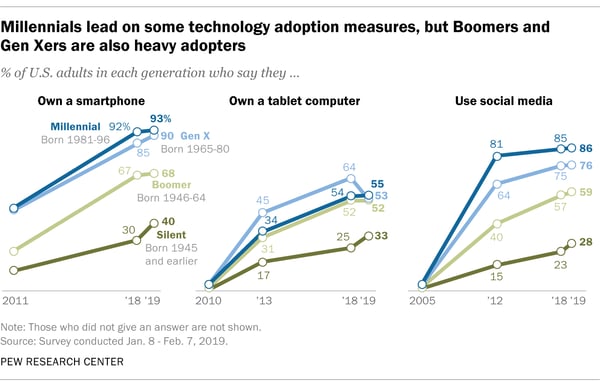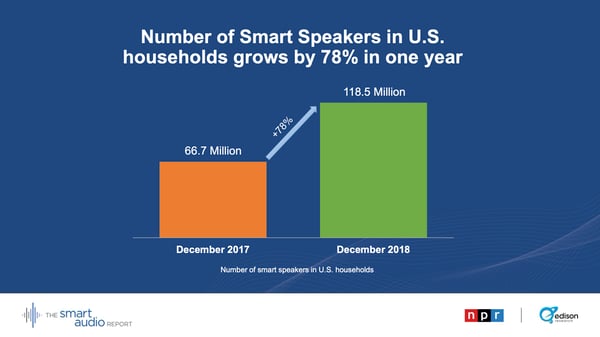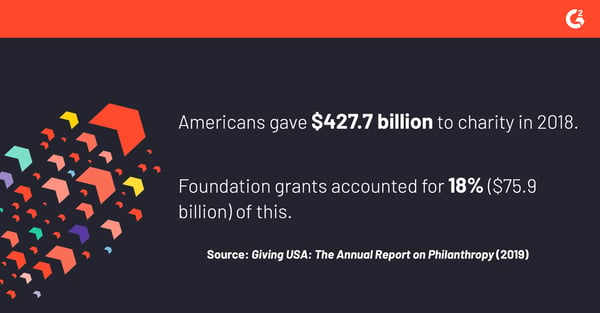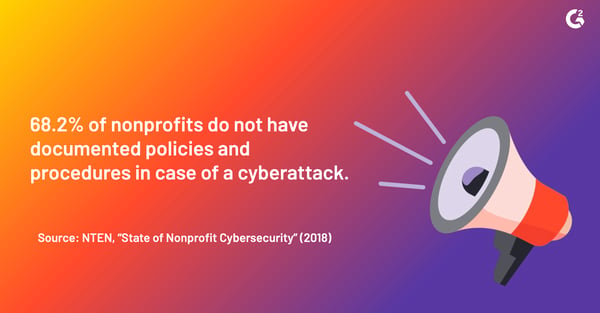This post is one part of G2's 2020 digital trends series. Read more about G2’s approach to digital transformation trends in an introduction from Michael Fauscette, G2's chief research officer.
Let’s skip the “nonprofits are afraid of innovation and change” diatribe and cut to the chase. Ubiquitously, nonprofits understand that technology is vital to their daily operations. Despite barriers such as cost and tech literacy, nonprofit leaders are slowly acknowledging that organizations making smart technological investments are outperforming organizations which don’t. The nonprofit sector has always lagged behind others in terms of innovation, however, my predictions for next year see organizations making an earnest effort to catch-up.
| RELATED: Learn 7 pain points that can hinder success in the nonprofit sector, here → |
The best part? Nonprofits won’t need to shell out tons of money to adopt these trends. For organizations of all sizes, balancing affordability with necessity will continue to be a challenge when it comes to modernizing technological strategy. While software upgrades aren’t in the cards for some organizations, smarter use of existing tech and various free platforms can help improve organizational efficiency. Nonprofits don’t have much choice in the matter; no one expects them to adopt the newest software or gadgets, but there is rising pressure from funders to demonstrate significant impact before they earn funding. Technology can help alleviate some of this burden so nonprofits can focus on work that advances their mission.
Alright, bring on the 2020 trends!
Nonprofit trend #1: Millennials drive digital adoption
Currently, there are somewhere between 73-79 million millennials living in the United States. In 2019, they surpassed baby boomers as the nation’s largest living adult population; they account for roughly 35% of the labor force in the United States. Millennials, in spite of all the criticism, have spurred digital transformation across multiple industries.
 Source: Pew Research Center
Source: Pew Research Center
Thus far, millennials have led the way when it comes to adopting and using technology, but Pew Research Center’s data shows Gen Xers and Boomers aren’t entirely lagging behind. This is important to note, especially when looking at how nonprofit staffing tends to skew in terms of age. Typically, leadership roles are filled by Gen Xers and Boomers, with millennials rounding out the entry level and managerial roles. According to Mobile Cause, the nonprofit workforce mirrors the national workforce in terms of millennial representation; roughly 50% of nonprofit employees are millennials, by 2025 that percentage will be about 75%.
We’ll continue to see nonprofit millennial employees pressuring their upper level staff to devote time and resources to exploring avenues for improved technological solutions. Additionally, these employees will likely (willingly or unwillingly) manage digital identity (social media, e-campaigns, website maintenance) and compile research for tech options. However, with Gen Xers and Boomers continuing to close the gap on technology adoption, it’s likely this will be a collaborative effort as time goes on.
Outside the workforce, millennial donors are pressuring nonprofits to make improvements when it comes to digital identity. As millennials move into their prime earning and spending years, industries are scrambling to capture their attention. For nonprofits, that means devoting more time to mobile optimization and digital fundraising strategies that include video content, crowdfunding, and peer-to-peer initiatives.
| RELATED: Learn how crowdfunding changed the fundraising landscape, here → |
Nonprofit trend #2: Voice-command fundraising
Fundraising innovations took off with the advent of credit card donations, followed by text giving, now, voice-powered donations have the potential to shake up fundraising again. In April 2018, Amazon unveiled their Alexa Donations feature, enabling users to make donations to charities using a simple voice command. As of November 2019, the total number of nonprofits utilizing this feature has grown from 48 to 335. With over 100 million Alexa devices sold, the implications of this feature could drastically change fundraising channels. The unparalleled convenience of donating to a charity through a voice command could drive more individual contributions, and add another revenue stream for nonprofits without much active maintenance.
The cost and effort to adopt these tools are low for nonprofits. Nonprofits can mobilize supporters in an unprecedented way, giving people the option to donate from virtually anywhere. Despite growing data privacy concerns regarding smart speakers and voice assistants, they continue to rise in popularity. According to a recent study released by NPR and Edison Research, 21% of people in the United States aged 18 and older own a smart speaker. In 2018, roughly 14 million people became first-time speaker owners.

Source: National Public Media
Tools like Alexa and Google Home are an everyday asset in the lives of millions of people, and nonprofits must leverage these tools to convert donors. These solutions won’t come without some headaches. How much additional information will users need to provide if there are multiple nonprofits with the same name? Will there be instances where the speaker mishears the dollar amount and processes an incorrect donation, even after being corrected? There’s also the looming question of whether nonprofits will explore advertising via Apple Music and Spotify for donations.
Nonprofit trend #3: Predictive analytics in grantmaking
The public sector has taken the lead in exploring the benefits of predictive analytics when it comes to grants management, but private grantmaking foundations are taking notes. GrantSolutions.gov has worked with 10 federal agencies to incorporate predictive analytics and machine learning in the grant management process; their pilot model has a 96% accuracy rate on whether poorly written applications will be rejected. With tools that filter out low quality proposals, grant officers and managers can devote more time to promising applications.
On the other hand, private grantmaking foundations aren’t necessarily drowning in workload such that they need predictive analytics or machine learning tools, but they can still benefit. For example, private foundations often work with smaller grantmaking budgets compared with public funding opportunities, therefore, there is more pressure to invest their limited resources wisely. If foundations could assess a nonprofit’s proposed program and compare it to data from similar projects, they’re empowered to make smarter funding choices based on the potential impact of the proposed program, instead of an existing relationship with the nonprofit.

Foundations can adjust their funding priorities, including focus areas, total dollars allocated per cause, or the guidelines they use to measure program efficacy. Foundations can assess how nonprofits receiving renewal funds perform year over year and identify misuse of funds or areas for improvement that would lead to greater outcomes. Predictive analytics is entirely dependent on the quality of data, luckily foundations and nonprofits collect lots of data that could help power these tools.
Nonprofit trend #4: Blockchain platforms and cryptocurrency
According to Azati, a blockchain platform can cost as little as $5,000 to upwards of $200,000 to develop. Many nonprofits operate on a tight budget, so not many organizations will build out their own platform. Additionally, blockchain isn’t known for being user-friendly, and nonprofits usually lag behind in tech literacy. Instead, nonprofits will benefit from existing blockchain platforms designed for them. Luckily, many blockchain platforms built for nonprofits have emerged the last several years.

Blockchain platforms offer transparency to nonprofits, ensuring donors know their money and personal information are handled properly. Research shows that public trust and confidence in nonprofits has dropped to roughly 57%, an all-time low. Donors want nonprofits to be upfront about where their money goes, and how organizations impact real change. Blockchain fundraising platforms--such as BitGive, BitHope, and GiveTrack--allow donors to directly give to causes and receive proof that their money contributed to a goal—this also ensures that nonprofits don’t mishandle money behind the scenes.

Cryptocurrency fundraising will be the most popular blockchain use case exhibited by nonprofits. Fidelity Charitable’s 2019 Giving Report shows that $30 million in cryptocurrency was donated to nonprofits in 2018; a total of $106 million has been donated since Fidelity started accepting cryptocurrency in 2015. This is only one portion of the hundreds of millions in cryptocurrency donations made to nonprofits. Cryptocurrency donations offer the same benefit to donors as stock donations--they can avoid sizeable capital gains taxes. The government views cryptocurrency as property, allowing individuals to write off the fair market value. As the government grapples with how to handle these virtual currencies, it’s unclear whether that tax benefit will stick around.
Nonprofit trend #5: Cybersecurity
PREDICTION:
Nonprofits will prioritize cybersecurity investments and increase their budget by at least 15%.
In late October 2019, the American Cancer Society fell victim to an e-skimming malware attack that compromised the credit card numbers of users that accessed the organization’s online store that week. Even monolithic nonprofits are extremely vulnerable to these types of cyberattacks, and they must ensure they are doing all they can to protect sensitive user data. The World Economic Forum’s Global Risks Report 2019 found that 82% of respondents expected the risk of cyberattacks to increase, leading to monetary and data theft. The nonprofit sector is still painfully unprepared to defend against cyberattacks, and that needs to change.

Nonprofits collect a broad range of compromising information about their donors and clients, neglecting to implement a robust cybersecurity infrastructure could result in the loss of supporters’ trust if that data is breached. Nonprofits can face legal trouble since lots of collected donor data is protected by law. For human services nonprofits, data breaches can be especially serious if health information is compromised.
Compared to other trends, cybersecurity is an area where nonprofits need to dedicate financial resources towards development. The average global cost of a data breach in 2019 was roughly $3.92 million; that’s the entire organizational budget for most small nonprofits. Many organizations are one unfortunate cyberattack away from closing their doors, that should scare them into taking preventative action. Even less severe attacks like a website or social media hack can severely damage their external image.
Whatever the excuse--budget constraints, lack of time, lack of staff knowledge, or feeling a false sense of security-- nonprofits should conduct an audit of their existing cyber infrastructure and make internal systemic changes to improve security measures. Even simple steps such as adopting password managers or data privacy protection in the form of web browser extensions go a long way to beef up a nonprofit’s defenses. Considering the surge in mobile fundraising and voice command fundraising, nonprofits must enact strong data management practices to keep their donor data secure.

The nonprofit sector is warming up to change
While the nonprofit sector isn’t traditionally known to be forward thinking, organizations are eager to catch up and adapt to the trends that will bridge the technological gap between them and their supporters. The pressure to build transparency and deliver high-performing programs and services will push nonprofits to make smarter technological investments. Nonprofits are slowly shedding their myopic view that upfront costs preclude all tech improvements. Now, they just need time to assess what’s working, and how tech might help facilitate change.
Explore the highest-rated software in related categories:












 by Dominick Duda
by Dominick Duda
 by Dominick Duda
by Dominick Duda
 by Dominick Duda
by Dominick Duda